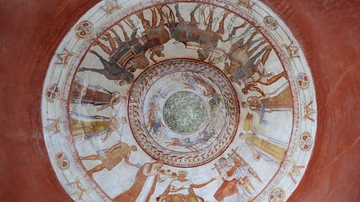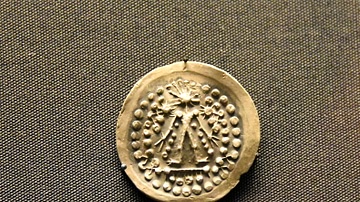Search
Did you mean: Ugarit?
Search Results

Image
Amphora-Rhyton from Kukouva Mogila Tumulus, National Archaeological Institute with Museum - BAS
Silver-gilt amphora-rhyton from Kukouva Mogila tumulus, Duvanlii. Early 5th century BCE. National Archaeological Institute with Museum - BAS. Photo: Nikolay Genov in catalogue of the exhibition Los Tracios. Tesoros enigmáticos de Bulgaria...

Image
Painted Tomb, Kazanlak
Tomb in the town of Kazanlak, Bulgaria. Painted in dromos and dome camera.
Dromos - scene with battle scenes
Dome camera - a scene with a symposium
Beginning of the 3rd century BCE.
Photographer: Marin Karavelov (used with permission)

Image
Celtic Coin from Thrace Copying Greek Inscription
Early Iron Age Celtic people copied Greek coins, often faithfully reproducing their designs and inscriptions. This suggests that Thracian die-engravers were illiterate, as legible Greek letters were gradually replaced by abstract patterns...

Video
Unveiling Slavic Myths - A Conversation With Noah And Svetlana
Slavic cultures are far-ranging, comprising East Slavs (Russia, Ukraine, Belarus), West Slavs (Czech Republic, Slovakia, Poland) and South Slavs (the countries of former Yugoslavia plus Bulgaria), yet they are connected by tales of adventure...

Definition
Europe
Europe is a continent forming the westernmost part of the land mass of Eurasia and comprised of 49 sovereign states. Its name may come from the Greek myth of Europa, but human habitation of the region predates that tale, going back over 150,000...

Definition
Treaty of Brest-Litovsk
The Treaty of Brest-Litovsk, signed on 3 March 1918, outlined the harsh conditions under which the crumbling Russian Empire withdrew from the First World War (1914-18). Negotiated by Vladimir Lenin (1870-1924), the leader of Soviet Russia...

Definition
Ottoman Empire
The Ottoman Sultanate (1299-1922 as an empire; 1922-1924 as caliphate only), also referred to as the Ottoman Empire, written in Turkish as Osmanlı Devleti, was a Turkic imperial state that was conceived by and named after Osman (l. 1258-1326...

Definition
Operation Barbarossa - Hitler's Invasion of the USSR
Adolf Hitler (1889-1945), leader of Nazi Germany, attacked the USSR on 22 June 1941 with the largest army ever assembled. The Axis offensive of June-December 1941 was code-named Operation Barbarossa ('Redbeard') after Frederick Barbarossa...

Definition
Treaty of Versailles
The Treaty of Versailles, signed in June 1919, was an agreement between the victors of the First World War (1914-18) which redivided parts of Europe and imposed reparations, armament limitations, and total blame for the war on Germany, one...

Definition
Cathars
The Cathars (also known as Cathari from the Greek Katharoi for “pure ones”) were a dualist medieval religious sect of Southern France which flourished in the 12th century and challenged the authority of the Catholic Church. They were also...